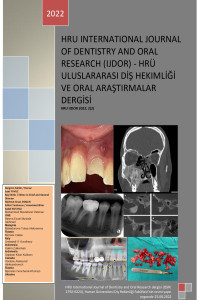Treatment of young permanent teeth pulpitis with formocresol pulpotomy
Treatment of young permanent teeth pulpitis with formocresol pulpotomy
formocresol, pulpotomy, permanent teeth endodontics, pulp biology,
___
- 1. Yıldız Ş, Doğan MS. The Importance of Primary Teeth in Children’s Health. Research & Reviews in Health Sciences, 2021;143-150.
- 2. Daloğlu M, Güzel U, Görkem K. Root canal treatment for deciduous teeth: a review Meand Med Dent J, 2017;18:80-5.
- 3. Kulkarni GK, Dogan MS, Akleyin E, Yavuz I. Analysıs of Failures of Pulpotomy Treated Prımary Teeth: Page 3 of 6 A Case Series and Review. J Dent Oral Disord Ther 2021;9(1): 1- 6.
- 4. Leite AC, Rosenblatt A, da Silva Calixto M, da Silva CM, Santos N. Genotoxic effect of formocresol pulp therapy of deciduous teeth. Mutation Research/Genetic Toxicology and Environmental Mutagenesis. 2012;747(1):93-7.
- 5. Zarzar PA, Rosenblatt A, Takahashi CS, Takeuchi PL, Júnior LC. Formocresol mutagenicity following primary tooth pulp therapy: an in vivo study. Journal of dentistry. 2003;31(7):479-85.
- 6. Moretti AB, Sakai VT, Oliveira TM, Fornetti AP, Santos CF, Machado MA, Abdo RC. The effectiveness of mineral trioxide aggregate, calcium hydroxide and formocresol for pulpotomies in primary teeth. International endodontic journal. 2008;41(7):547-55.
- 7. Chandrashekhar S, Shashidhar J. Formocresol, still a controversial material for pulpotomy: A critical literature review. Journal of Restorative Dentistry. 2014;2(3):114.
- 8. Ward J. Vital pulp therapy in cariously exposed permanent teeth and its limitations. Australian Endodontic Journal. 2002;28(1):29-37.
- Başlangıç: 2021
- Yayıncı: Harran Üniversitesi
SURGICAL TREATMENT OF AGGRESSIVE TYPE CENTRAL GIANT CELL GRANULOMA:A CASE REPORT
Halil İbrahim DURMUŞ, Saliha Zeynep AÇAR
Faruk ÖZTEKİN, Tuba TALO YILDIRIM, Osman ATAŞ, Melek Didem TOZUM
Yasemin YAVUZ, Ebru AKLEYİN, Zeki AKKUŞ, Mehmet Emin DOĞAN
REMOVAL OF A BROKEN PATHFILE: CASE REPORT
DOĞU ANADOLU BÖLGESiNDEKi TÜRK ÇOCUKLARINDA DiL ANOMALiLERiNiN YAYGINLIĞI
Sacide DUMAN, Pelin Senem ÖZSUNKAR
DİŞ SÜRMESİNDE D VİTAMİNİNİN ROLÜ; DERLEME
Meryem ŞAHİN, İsmet Rezani TOPTANCI
FIBROUS DYSPLASIA : A CASE REPORT
Halil İbrahim DURMUŞ, Saliha Zeynep AÇAR
Treatment of young permanent teeth pulpitis with formocresol pulpotomy
CA(OH)2 APEXIFICATION TO A TOOTH WITH CHRONIC APICAL ABSCESS: A CASE REPORT
